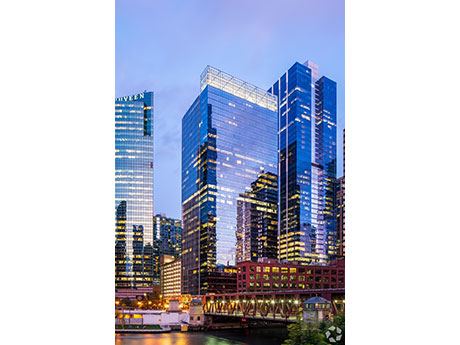By Steven Bauer, Colliers
The office towers that define Chicago’s landscape have unique histories and personalities, but not all are created equal in the eyes of the tenant. Buildings seeing the highest demand, classified even higher than Class A, are “trophy buildings” — buildings with high-quality finishes, newer and more efficient construction, and are often amenity rich with exclusive lounges, rooftop decks, fitness centers and private bars.
It’s especially important in today’s market to distinguish between the two distinct building categories because while Chicago’s real estate market is a vibrant and complex one, there is more to the story than what you see in the headlines. While the overall vacancy rate in the Loop remains at a historic high above 25 percent, trophy space vacancy is under 10 percent, and demand continues to be robust.

The story of flight to quality and flight to trophy assets has been told repeatedly since the COVID pandemic — complete with statistics that back the trend up. In the fourth quarter of 2024 alone, owners of trophy class buildings finalized anchor tenant renewals with Mayer Brown and PwC, both of whom kept roughly the same square footage as they had previously leased. With the trophy market being so “tight,” we are now beginning to see new winners emerge in Chicago’s central business district.
The flight to quality is affecting other well-capitalized and high-quality Class A properties and creating a spillover effect. With trophy quality assets seeing continued demand, coupled with a lack of any large office towers currently under construction in the Loop, the market is beginning to yield significant winners outside of this traditional asset class. This next wave of emerging winners has a common profile — they are buildings that have a well-capitalized ownership structure and are highly amenitized.
Signing tenants requires large capital expenditures in the form of concessions such as tenant improvement dollars and rent abatement, and if an owner does not have the capital, it is very difficult (if not impossible) to facilitate a transaction. These proactive owners are often embarking on renovation projects to attract and retain tenants. A few examples of buildings with significant recent momentum include:
• 225 W. Randolph: This property sat vacant until Onni purchased the asset and embarked on a full-building overhaul. Armed with historic tax credits and a vision to create three full floors of amenities at the top of the building, a leasing frenzy ensued in 2024 and has carried over into this year. Arguably the most highly amenitized building in the city, 225 W. Randolph has gone from 0 percent occupied to 60 percent-plus today and is expected to be fully leased in 2025.
• 191 N. Wacker: Owned by Allianz and Manulife, the building has zero debt. In signing a major tenant in late 2024, ownership committed to enhancing the building amenity package and soon after announced a two-floor deal with Neuberger Berman.
• 10/120 S. Riverside: The two-building complex is owned by Ivanhoé Cambridge. In working with asset manager Hines, Ivanhoé embarked on a $70 million-plus overhaul of the property over the past two years. With the renovation coming to a close, well-capitalized Ivanhoé has completed a steady stream of lease transactions all while continuing to not only hold net rents but also push them higher given strong demand.
With tenant demand continuing to improve, brokers across Chicago anticipate this spillover effect to persist and for more winners to emerge. With no new buildings currently under construction in the Loop, high-quality assets are expected to outperform the broader market in the near and mid-term.
Steven Bauer is an executive vice president with Colliers. This article originally appeared in the March 2025 issue of Heartland Real Estate Business magazine.


